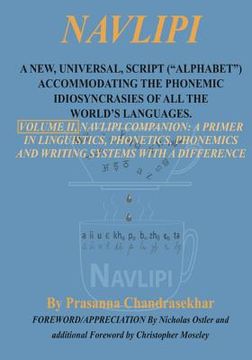Navlipi, Volume 2, A New, Universal, Script ("Alphabet") Accommodating the Phonemic Idiosyncrasies of All the World's Languages.: Volume 2, Another Lo (in English)
Synopsis "Navlipi, Volume 2, A New, Universal, Script ("Alphabet") Accommodating the Phonemic Idiosyncrasies of All the World's Languages.: Volume 2, Another Lo (in English)"
Navlipi, Volume 2, A New, Universal, Script ("Alphabet") Accommodating the Phonemic Idiosyncrasies of All the World's Languages. Volume 2, Another Look At Phonic and Phonemic Classification: Navlipi, By Prasanna Chandrasekhar. This book presents a new, universal script, denoted NAVLIPI, capable of expressing all the world's languages, from English and Arabic, to tonal languages such as Mandarin, to click languages such as !Xo Bushman. Based on the Roman script, NAVLIPI uses just five new or transformed letters (glyphs) in addition to the 26 letters of the Roman script; it uses no diacritics, rather making heavy use of "post-ops", post-positional operators. Its expression is very facile and intuitive and highly amenable to cursive writing as well as keyboarding and voice transcription. More scientifically and systematically organized than even Hangul, NAVLIPI incorporates essential features of a universal script, thus far present in no world script to date, such as universality, completeness, distinctiveness, and practical phonemic application. It addresses the serious deficiencies of the alphabet of the International Phonetic Association. Most importantly, NAVLIPI addresses phonemic idiosyncrasy, for the first time ever in any world script; among other things, phonemic idiosyncrasy makes transcription, in the same script, of, e.g. Mandarin and English, or Hindi/Urdu and Tamil, extremely difficult. It is felt that NAVLIPI is introduced at an appropriate time for a globalized world, which needs a single script in which it is easy and intuitive to transcribe all of the world's languages; it may also assist in the preservation of endangered languages. Apart from presenting the new script, the book also presents a thorough review of nearly all prior art through five millennia to the present, a basic discussion of phonetic and phonemic classification, "exercises" in coming up with new scripts, a glossary of terms, and more than 620 detailed references in linguistics and related fields. Nicholas Ostler makes the following observation: "NAVLIPI is a systematic extension of Roman script with a number of aims in view: To be a practical (legible and writable) script for all the world's languages, but at the same time to represent the languages' sounds exactly and consistently, making no compromises on the phonemic principle. In this ambitious goal, it goes beyond existing scripts: Beyond ordinary Roman scripts, because it requires that its symbols are interpreted the same way everywhere; beyond phonetic scripts such as the International Phonetic Alphabet, by representing phonemes singly, rather than as a set of phones; and beyond all the other scripts, by attempting to replace every single one of them without loss of significant phonetic detail. This is a stupendous aim for a single system created by a single scholar. The main obstacle to Chandrasekhar's achievement is the phenomenon of "phonemic idiosyncrasy", whereby the actual speech sounds are organized into different, and cross-cutting, significant sets in various languages: For example, p, whether aspirated or un-aspirated, is the same phoneme in English, but the two versions belong to contrasting phonemes in Hindi, where (however) f is heard as the same sound as aspirated-p. By juxtaposing letters, Chandrasekhar conjures up new symbols that represent directly the complex phonemic reality. The attempt to have all the possible virtues of a phonetic writing system at once - on the basis of a single man's ideal - is what makes this a heroic endeavour."

